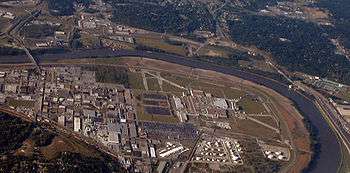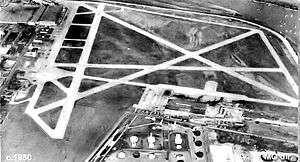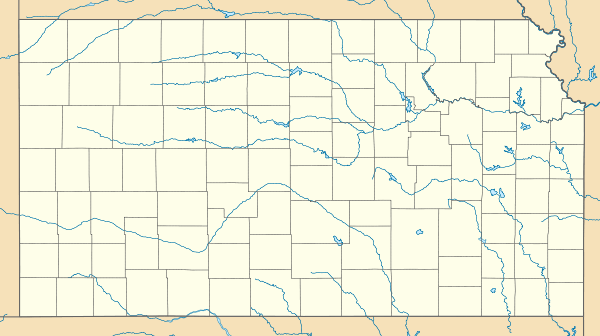Fairfax Municipal Airport
Fairfax Municipal Airport (known as Fairfax Field during World War II) was a Kansas City, Kansas airfield from 1921 that was used during 1935–1949 by the military. Federal land adjacent to the airfield included a WWII B-25 Mitchell plant and modification center and a Military Air Transport terminal. After being used as a Cold War-era Air Force Base, it was used for airliner servicing by TWA and for automobile and jet fighter aircraft production by General Motors, which built a 1985 Fairfax Plant over runways when the municipal airport closed.
Fairfax Municipal Airport | |
|---|---|
 The remaining runway sections of the airport are along the Missouri River (right) and on the north and east of the General Motors Fairfax Assembly Plant (right of center).
 Similar northward view in World War II: by 1949 runways were 6,500 ft (2,000 m), 6,100 ft (1,900 m), 5,800 ft (1,800 m), and 4,500 ft (1,400 m).[1] | |
| Summary | |
| Airport type | defunct |
| In use | 1921–85 |
| Coordinates | 39°08′53″N 094°35′59″W |
| Map | |
 Fairfax Municipal Airport Located mostly within Kansas, the Fairfax airport was north of the Kansas City Downtown Airport in Missouri. | |
Background
The airport site is on the Goose Island (Kansas) river bend. At Goose Island, the United States Government constructed flood protection levees and walls around the Fairfax Industrial District, as well as three pump houses including two on the airfield[3] that was first used for a 1921 "American Legion air meet".[4] The airfield was subsequently used by Emory J. Sweeney's School of Aviation.[4]
Sweeney Airport
Sweeney Airport was named in 1925, and the 403 Pursuit Squadron was assigned to Kansas City at the end of 1925.[5] The "Fairfax plat" map with the airport was drawn on April 1, 1925, as an area "of 1,373.07 acres" outside the city limits divided as follows: "The Kansas City Industrial Land Company owned 1,122.85 acres; the Union Pacific Railroad Company owned 32.80 acres; eight private owners owned 72.18 acres; two railroads other than the Union Pacific owned 66.47 acres; land set aside for dedicated roads was 31.54 acres; [and] land on which dikes were built was 57.23 acres."[3] Sweeney Airport was mapped by the United States Department of Commerce on July 17, 1928, as a trapezoid with 150 acres (61 ha).[6]
Fairfax Airport
Fairfax Airport was named in 1928 when Sweeney Airport "was taken over by Wood Brothers Corporation"[4]--Charles Lindbergh and Phil Love landed at the port "in Love's Ryan monoplane" on August 2, 1928.[7] Dedicated in 1929, the facility was operated by the "Fairfax Airport Company" ("Fairfax Airports, Inc." in 1931),[8] and the 1st Fairfax passenger service aircraft was a Fokker Super Universal cabin plane (5 passengers) of the Universal Aviation Corporation.[4] The Southwest Air Service Express airline scheduled flights from "Fairfax Airport" to Dallas/Ft Worth in March 1929,[9] and a "Travelair six-passenger carrier of Central Air Lines crashed on approach to Fairfax in January 1930.[10] An "impressive structure" costing $60,000 and with pay toilets for extra profit was built in 193x as a new administration building, and the land also had a natural gas field with 14 wells for extra revenue[8] (a post-WWII Phillips Petroleum tract was along tanks of the Great Lakes Pipe Line Company.) In 1933, the airport had hangars; airlines including American, Braniff, and US Airways; and aircraft manufacturers such as Rearwin Airplanes[4] (American Eagle Eaglet aircraft were also being produced.)[11] By 1938, the Eddie Fisher Flying Service used Waco RNF aircraft for flight instruction.[12]
Military support
Adjacent to Fairfax Airport was a 1935–42 naval reserve air base,[13] which by 1940 was a Navy Elimination Air Base ("E-base", colloq.) for screening aviation candidates.[14] Survey work for an Air Force Plant began in December 1940, and the city purchased the airport in February 1941[15] for $600,000 from the Kansas City Industrial Land Company. The United States Army Air Forces (AAF) leased the city's Fairfax Airport by 1941; when the Works Projects Administration allotted $1,536,717 for improvements and expansion of the 240-acre (97 ha) airport.[16] The 4 civilian runways were improved with concrete of 150 feet in width and 185,000 square yards of parking apron.—the government also purchased an alfalfa field of 75 acres (30 ha)[17] for the AAF plant and for right-of-way to the airfield. Groundbreaking for Air Force Plant NC, a "government-owned, contractor-operated" plant of North American Aviation[18] was on March 8, 1941. (a USAAF Modification Center was built May–October 1942[4]—a different modification center was at Kansas City, Missouri.)[19] Fairfax's civilian manufacturing facility for Rearwin airplanes was bought in early 1942 by "Australian-owned" Commonwealth Aircraft Company which also opened a 2nd airplane factory in Kansas City, Missouri, at West Bottoms.[20] Military Air Transport Service moved an air freight terminal to Fairfax on 2 March 1945 from Kansas City, Missouri, and the Fairfax military installation became an operating location of Rosecrans Army Airfield on April 15, 1945 (the Air Transport Command operating location at Fairfax was discontinued by December 6, 1945.)
Post-war operations
By late 1945 Transcontinental and Western Air used the former modification center for aircraft maintenance until the Great Flood of 1951—the city built the new Mid-Continent Airport for the TWA Kansas City Overhaul Base west of the city (the modification center was razed shortly after March 1985.) Commonwealth Aircraft produced post-war Skyranger aircraft at Fairfax until "transferred in 1946 to the former Columbia Aircraft factory" in New York, and the Buick-Oldsmobile-Pontiac Assembly Plant adjacent to Fairfax Field[21] operating in the leased former bomber plant[22] "finished its first automobile in June 1946".[23] Post-war military activations at Fairfax included the 4101st Army Air Force Base Unit (Reserve Training) on July 12, 1946[24] and the 564th Bombardment Squadron on January 6, 1947.
Despite a 1948 plan for the base to "be withdrawn from surplus",[25] in "October 1949 the U.S. Air Force terminated its lease on Fairfax Airport, and the city of Kansas City, Kansas, regained control of the facility".[23]:260 An "annexation ordinance" expanded the city limits to encompass the "United States Government [area of] 2 acres" and the airport's 925.8 acres (374.7 ha) with 13 buildings—the "Fairfax plat" was the area within the northeast corner of the Fairfax Industrial District of ~2,300 acres (930 ha).[3] On May 22, 1950, Fairfax's 2472d AF Reserve Training Center and 442d Troop Carrier Wing moved to Naval Air Technical Training Center Olathe. In 1950 Mid-Continent Airlines was contracted for airmail out of Fairfax (North Central Route#106 operations moved to the Mid-Continent Airport after the 1951 flood.) The 4610th Air Base Squadron at Fairfax Field became the April 1951 base operating unit for the nearby Air Force Base under construction at Grandview Airport[26] (Fairfax's Air Defense Command units moved to Grandview Air Force Base after beneficial occupancy on February 16, 1954.)[27]
Municipal airport
Fairfax Municipal Airport was named by the time of the Great Flood of 1951[28] and in 1953 the F-84F Thunderflash aircraft assembly line was in the same 53-acre (21 ha) GM Assembly Plant.[21] On June 20, 1954 a Zantop DC-3A crashed on approach to Fairfax, killing 3.[29] Fairfax was the July 12, 1955 landing site of a TWA DC-3 trainer that "had just taken off from Fairfax" before colliding with and destroying a Cessna of Baker's Flying Service.[30] The 1963 fatal journey for Patsy Cline's Piper Comanche began at Fairfax, and the airport was added to the GNIS on October 13, 1978.[2] Fairfax's longest runway (17/35) was 7,301 ft (2,225 m) long when the airport's last flight departed on March 31, 1985,[23] and on April 1, 1985, the land was added to the Fairfax District industrial area. The General Motors Fairfax Assembly Plant was completed in 1985 on the runways,[31] and auto production at the WWII bomber plant building ceased in May 1987 (GM had purchased it in 1960 and it was razed in 1989).[32]
References
- title tbd (aeronautical chart) (Map). available at the National Airline History Museum, Kansas City (partially online at Airfields-Freeman.com). 1946. Retrieved 2013-07-14.
- "Fairfax Municipal Airport (478637)". Geographic Names Information System. United States Geological Survey. Retrieved 2013-07-14.
- STATE, EX REL. v. City of Kansas City, 222 P.2d 714 (Kan. 1950) ("The Fairfax Industrial District consists of approximately 2,300 acres of land formerly owned by the Kansas City Industrial Land Company, which company sold tracts to various persons and corporations, including tracts of about 925 acres in the northeast portion of the district to the city of Kansas City for a municipal airport, now known as Fairfax airport. [...] Since 1925, by accretions and the addition of Goose Island, 900 acres were added, 700 acres of which are part of the city's airport (T. 523), making a total acreage area at this time of about 2.300 acres. [...] The airport statute [...] gives the city the same jurisdiction and police power over its airport, even though the airport is located outside the city limits, as it has over any part of the city located within the city limits.").
- Freeman, Paul (December 29, 2012). "Sweeney Airport / Fairfax Airport / Fairfax Army Airfield (KCK), Kansas City, KS". Abandoned & Little-Known Airfields: Eastern Kansas. Airfields-Freeman.com. Retrieved July 14, 2013.
- Maurer, Maurer. Aviation in the US Army, 1919–1939 (Report). pp. 151, 307. ISBN 0-912799-38-2.
In addition the Air Service built facilities at Boston; Pittsburgh; Columbus; Cincinnati; Louisville; Kansas City, Missouri; Santa Monica, California; and Seattle. In each case, it leased the land for one dollar a year, furnished steel hangars from its surplus, and contracted through the Quartermaster Corps for erecting hangars and installing gas and oil facilities. The Air Service supplied a few Jennies, some equipment and tools, a few mechanics (mostly Regular enlisted men but occasionally a civilian or two), and a Regular Army officer as commander.22 … The Air Service … in 1923 it added a southern division from Scott to Kelly Field by way of Kansas City, Missouri; Muskogee, Oklahoma; and Dallas.12 … Other examples were the 403th [sic] at Kansas City, Missouri, which worked with the Iowa National Guard in a Minnesota camp during 1935.34 … By 1925, the Signal Corps had created new weather stations and every Air Service flying field had a Signal Corps weather detachment. … Some places on the Model Airway still did not have weather service in 1925. Five new detachments authorized by the War Department at the end of the year were assigned to Cumberland, Uniontown, Kansas City, Muskogee, and Dallas.
- "Commerce Department" (Map). Airway Bulletin (aeronautical chart). partially online at Airfields-Freeman.com. Retrieved 2013-07-14.
- "Lindy Studying Nation's Airports for New Service" (PGarchiver.com article preview). The Atlanta Constitution. August 2, 1928. Retrieved 2013-07-16.
Colonel Charles A. Lindbergh landed at the Fairfax airfield here late today from Wichita, Kans., accompanied by Phil Love, in Love's Ryan monoplane.
- Bednarek, Janet Rose Daly (12 June 2019). America's Airports: Airfield Development, 1918-1947. Texas A&M University Press. ISBN 9781585441303. Retrieved 12 June 2019 – via Google Books.
- "Southwestern Air Express to Be Started Next Week" (Google news archive). St. Joseph Gazette. March 30, 1929. Retrieved 2013-07-14.
- "title tbd" (Google News Archive). newspaper tbd. Retrieved 2013-07-15.
- "article title tbd". Popular Aviation. December 1931.
- Haus, Charles, title tbd, quotation posted at Airfields-Freeman.com,
I learned to fly with the Eddie Fisher Flying Service at Fairfax in a Waco RNF and soloed in 1938.
- "Olathe Naval Air Station: Sailors on the Plains" (PDF). Album: Johnson County History Museum. XV (2). Archived from the original (article) on December 11, 2013. Retrieved 2013-07-15.
on December 18, 1941…Lieutenant Commander R.V. Murison of the Naval Reserve’s civil engineering corps came to inspect the Johnson County airport site
- Hammel, Eric (2010-01-22). Aces at War. ISBN 9781890988074.
- "Big Bomber Plant for City". Kansas City Times. December 7, 1940. (cited by Freeman and Macais)
- "Big Bomber Port" (Newspapers.com transcript). Kansas City Star. May 22, 1941. Retrieved 2014-08-16.
Fairfax Municipal Field Gets WPA Grant to Enlarge and Improve … An allotment of $1,536,717 has been made by the WPA for improvement and development of Fairfax municipal airport, it was learned in a telegram received today by Mayor Don C. McCombs from U. S. Guyer, representative in Congress from the second congressional district of Kansas. The appropriation is expected to provide about eighteen months’ work for more than 1,000 men. It will be a start in making Fairfax one of the outstanding airports in the country. Big Port Need Acute. Need of greater field facilities for flight testing twin-engined bombing planes to be assembled at the 10-million-dollar government-owned plant under construction on adjacent land was responsible for the appropriation receiving precedent over other demands, it was said. The present port includes 240 acres and will be nearly tripled in size by the improvement, which is to include filling and leveling of old Goose "island,” a part of the property acquired by* the city in the airport purchase. Runways will extend far out onto the old island, now a part of the mainland and protected on the Missouri river side by a 6-mile dike. … Fairfax airport now is an important national defense center as an adjunct to the bomber plant and also as the home of Richards field, [sic] United States army reserve air corps, and a base for the United States naval reserve aviation training. … The airport was purchased by the city this year and turned over to the board of public utilities for operation and maintenance. The board assumed the $750,000 bond obligation authorized by the voters at a special election for the airport purchase. An application for 2 million dollars was made to the WPA. That cleared through state and regional offices, was approved by the commander of the 7th corps area of the army and sent on to Washington for study by the war department,
- Kindelberger, James H (December 2, 1940), title tbd, Lyon Project Files (cited by Macias p. 247)
- Irving Brinton Holley Jr., United States Army in World War II, Special Studies: Buying Aircraft: Materiel Procurement for the Army Air Forces (Washington, D.C.: Government Printing Office, 1989), 294–301 (cited by Macias p. 246)
- Futrell, Robert F. (July 1947). Development of AAF Base Facilities in the United States: 1939–1945 (PDF) (Report). ARS-69: US Air Force Historical Study No 69. Air Historical Office. p. 141. Archived from the original (PDF) on 2012-09-08.
- "title tbd". KansasCityMuseum.org. Retrieved 2014-08-17.
Commonwealth Aircraft Company…In early 1942 it bought the family-owned Rearwin Airplanes that manufactured well designed light aircraft. Australian-owned Commonwealth won a U.S. government contract to produce Army Air Force troop-carrying tactical gliders in the Rearwin facility. A second factory was opened in Kansas City, Missouri on the present West-Bottoms site of the American Royal. Between 1942 and 1945 100 WACO CG-3A 8-place trainers and 1400 13-place WACO CG-4As rolled off the assembly lines – making Rearwin the second largest producer in the nation. Kansas City and Fairfax gliders were used in European operations from 1943 to the end of the war. … On the south edge of Kansas City on Bannister Road, Pratt & Whitney spent 85 million dollars constructing a 57-acre plant that employed 24, on a mile-long assembly line.
- "Air Force Unveils New Jet Fighter" (Google news archive). newspaper tbd. July 10, 1953. Retrieved 2013-07-14.
- "Rush Car Plant". Kansas City Star. November 7, 1945. (cited by Macias p. 260)
- Macias, Richard (Winter 2005–2006). ""We All Had a Cause": Kansas City's Bomber Plant, 1941–1945" (PDF). Kansas History: A Journal of the Central Plains. 28: 244–261. Retrieved 2013-07-14.
One out of every fifty B-25s was flown to the Cheyenne Bottoms Gunnery and Bombing Range near Great Bend to test fire the machine guns in flight. … In October 1949 the U.S. Air Force terminated its lease on Fairfax Airport, and the city of Kansas City, Kansas, regained control of the facility. The reconverted factory finished its first automobile in June 1946… In 1960 General Motors purchased the plant.
- History of the 4101st Army Air Forces Base Unit (AFHRA document) (Report).
- "Air Force to Reopen Bases". The New York Times. November 24, 1948.
To be withdrawn from surplus are Fairfax Air Force Base [sic] at Kansas City, Kan., and Cedar Grove Quartermaster Depot at Shreveport, La.
- Mueller (1982). "Richards-Gebaur Air Force Base". Air Force Bases as of 1982 (Report). p. 502.
- compiled by Johnson, Mildred W (31 December 1980) [February 1973 original by Cornett, Lloyd H. Jr]. A Handbook of Aerospace Defense Organization 1946–1980 (PDF). Peterson Air Force Base: Office of History, Aerospace Defense Center. p. tbd. Retrieved 2012-03-26.
- Ray Lewis (1951), Fairfax Municipal Airport [overhead sign] (online image available at Airfields-Freeman.com)
- Ranter, Harro. "ASN Aircraft accident Douglas DC-3A N49551 Kansas City, MO". aviation-safety.net. Retrieved 12 June 2019.
- "2 Die as Planes Collide at K.C." (Google news archive). Lawrence Journal-World. July 12, 1955. Retrieved 2013-07-14. (also available in the Southeast Missourian and the Kansas City Star, which described the investigation team.)
- "Fairfax Assembly Plant". Media.GM.com. 2013-06-20. Retrieved 2013-07-14.
- “Fairfax Decision Based on Economics,” Kansas City Times, July 16, 1988; “GM’s Old Fairfax Plant Burns,” Kansas City Star, January 19, 1989. (cited by Macias p. 260)